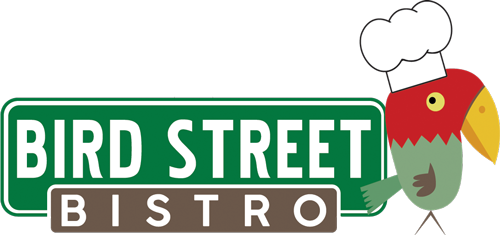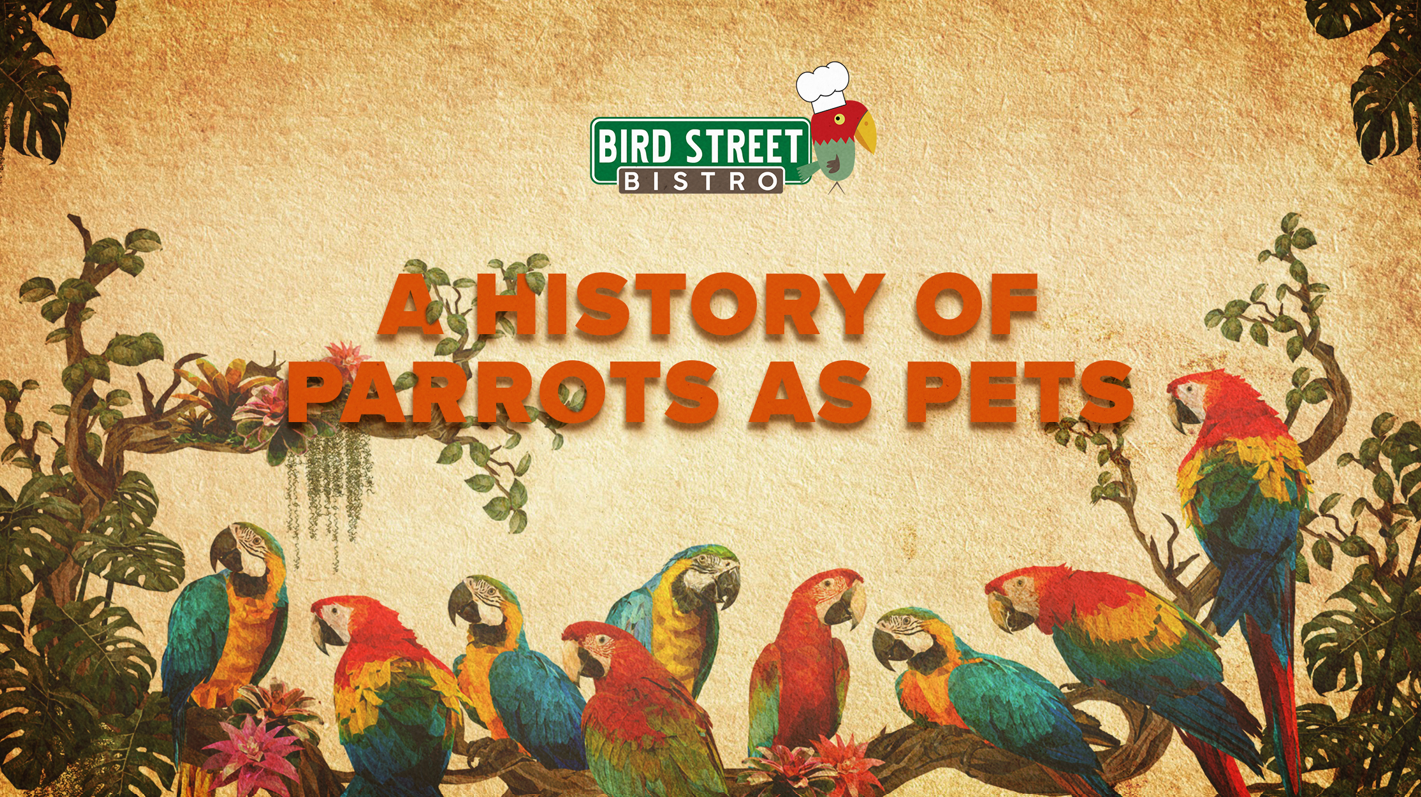A History of Parrots as Pets
Parrots have fascinated humans for many years with their colorful feathers and incredible intelligence. Today, parrots are the 3rd most popular companion animal in the United States. Even if you yourself don’t own a parrot, you’ve likely come across the many videos on social media showing various parrot's personalities and adventures with their owners.
Although many people have companion parrots in their homes, they are still largely considered undomesticated animals. This is because they are only a few generations removed from their previous family members in the wild. How then, did parrots come to be such a popular pet? From the very first interactions between parrots and humans to the relationships that we share with them today, there is a lot of history that shaped how we got here.
Humans and Parrots - The Beginnings

In 1987, a researcher in Brazil, with the direction from locals in the area, came upon drawings of what are believed to be macaws in a cave that have been dated back about 3,000 to 5,000 years. Dating is still being carried out to determine a more precise date, but even that long ago, humans were interested in these magnificent creatures enough to depict them in their art.
In 327 B.C. Alexander the Great began an expedition in the Indian subcontinent. There, he found Ring-Neck Parrots and the Alexandrine Parrot (which was named after him.) He decided to bring them back to Greece with him and that led to the first appearance of parrots in Europe. Those that kept parrots often housed them in cages that were elaborate and made of expensive materials.
As the Roman Empire grew and became more influential, parrots that were able to speak were very trendy among the most wealthy of households. In fact, these people were so fascinated by the bird's ability to talk that they would hire professional teachers that specialized in training parrots to speak Latin. Unfortunately, training methods were not usually healthy for the birds and some even encouraged hitting parrots on the head as part of their methods. This was thanks to instructions written in 77BC by Pliny the Elder, a proto-naturalist.
Soon, the Romans introduced parrots to the rest of Europe, and buying and selling parrots became more common.
Parrots Begin to Take Flight as Pets
Although interest in parrots as pets waned when the Roman Empire began to fall, it picked back up again when merchants and other travelers began to bring the parrots that they encountered in their travels back to their homes. People that came across the birds were fascinated by the exotic animals. At this time, parrots were still mostly owned by wealthier people and were still being held in cages that were mostly used for decoration and not as adequate housing for the birds inside of them.
By the third century A.D, some Chinese poetry would describe parrots. Birds kept at this time were often housed in cages decorated with jewels. In 1100, Chinese Emperor Huizong of Song is noted to have loved parrots. He even painted one in his work “Five-colored Parakeet on a Blossoming Apricot Tree.” He wrote a poem about the bird he painted and said “Heaven produced the parakeet, this unusual bird.” He also added “When he flies to the treetops, he seems envied by all feathered creatures.” In the 10th century AD, a well-known book the Kama Sutra claimed that one of the 63 things that a man must master in life is teaching a parrot to talk.

In the mid 1400s, The Portuguese controlled parts of West Africa and would often bring African grey parrots back with them from their travels there. Once the African greys talking abilities were discovered, people became fascinated with them. Even the church took note of their abilities and Pope Martin V appointed a “Keeper of the Parrots” to care for the parrots there.
Parrot interest started to spread again in 1493 when Christopher Columbus returned to Spain from his travels to the Americas. He brought some of the parrots that he encountered back with him to Spain and presented them to the king and queen. He said they were gifts from the Native Americans that he met in the New World.This led to even more interest in the area. Bird keeping and the use of bird cages for decorative purposes became extremely popular. A cage-makers guild was even created in France for expert crafters to create fancy, decorative bird cages.
During the early 15th century to the early 17th century, European ships traveled around the world searching for new trading routes. This was known as the Age of Exploration. Many animals were brought back for menageries (a private room in a house to which the lord of the manor would retreat to relax and entertain himself) Parrots were high on the list of desired additions to these menageries.
The 18th Century

During the 18th century and the Age of Enlightenment, Louis XV and Louis XVI ordered the creation of decorative bird cages made for aviaries in the gardens at Versailles. These cages were so overly decorated and embellished that the birds that lived inside of them were mostly just a side addition and were not the focus. As has been the case in the past, having these fancy, elaborate cages was common mostly in wealthy homes. In many cases, bird cages would be displayed without even having a bird to inhabit them.
In the mid-1800s, Budgerigars (parakeets) started to gain popularity in the West. Wealthier families would often have very intricate cages designed for their birds that were replicas of famous architecture. Jacob Wrey Mould was a British-born architect that arrived in New York in the 1850s. He designed many important structures as well as elaborate bird cages for Central Park. In the drawing below, you can see one of his designs.
The 1900’s
In 1929, the “Great Parrot Fever Pandemic” began. Parrot fever is known more specifically as psittacosis. Psittacosis is a bacterial infection that is deadly to parrots and can also be transmitted to humans. Psittacosis spread quickly in part because of the poor conditions birds were being transported in from South America. It also affected 750 to 800 people around the world, with a mortality rate of 15%. This horrible pandemic as well as World War II led to fewer people keeping parrots.
In the 1940s and 1950s, interest in parrot keeping began to surge again and this time budgies became extremely popular. As interest increased and more knowledge about the importance of proper care came to be, more cages and parrot food started to become available to consumers. However, knowledge of proper parrot nutrition was still pretty unknown. It wasn’t until the 1980s that formulated diets started appearing at pet stores. Before this, birds were still primarily eating seed and lacked fresh foods in their diet. Once veterinarians and owners started noticing that their birds weren’t thriving on these seed diets alone, the push for proper nutrition began.
Did you know that today Bird Street Bistro helps bird owners provide healthy nutrition choices through their line of parrot food? This food is an excellent addition to a bird’s diet and provides an enriching, tasty way for birds to enjoy their favorites. One of their most loved products is their AppleBerry Feast on the Fly.

In 1975, further interest in parrots occurred likely due to the popularity of Fred, the cockatoo in the television series, “Baretta.” Fred was actually played by two cockatoos named Lalah and Weird Harold. Weird Harold was used as a stunt bird for flying sequences. During this decade, pet shops also began displaying parrots out in the open, which made it so people began to interact with them more directly. This also helped further fuel interest in birds as pets.
In 1980 due to the ever-increasing interest in parrot ownership and demand for more ways to properly care for them, avian medicine became a specialty and the Association of Avian Veterinarians was established. Later, in 1993, the American Board of Veterinary Practitioners began offering board certification in avian medicine and surgery which led to it being considered a recognized veterinary specialty. This has led to more specialized healthcare for our birds. It also means that people have a better ability to ensure that their birds can see a doctor that understands their specific biology.
In 1989 the World Parrot Trust was established. They focused on bringing specialists together to help parrots both in the wild and in people’s homes have better lives. Some of the issues that they are facing are parrot conservation, protection, and overcrowding in parrot sanctuaries and shelters.
In 1992 The Wild Bird Conservation Act halted most imports of exotic birds into the United States. This was a huge win for those seeking to protect parrots from trade where they were often killed or treated poorly in the trapping and transportation process. Over-trapping and exporting of parrots has also contributed to some species now being endangered. Some, such as two of the four South American blue macaw species, the glaucous macaw, and the Spix’s (little blue) macaw are now set to be classified as extinct. Breeding started to become more popular with restrictions on the importation of parrots.
Today
Parrots continue to be popular pets today. Many people consider their birds a part of their family and have a better understanding of their needs. However, there is still a lot of work to do to ensure that they are getting adequate care and living the fullest lives possible. They are often rehomed or surrendered to rescues because of their specific needs as exotic pets and some owners’ inability to meet those needs. Many parrot shelters and sanctuaries have been established for displaced pet birds. Owner death, incompatible lifestyle changes, and impulse buying are some of the reasons that avian shelters have become necessary and often overcrowded.
The good news is that we now have more understanding and data than ever on how to properly care for our birds. The passage of time, its lessons and challenges, and the advancement of science and research have given us the ability to care for our birds better than ever. It is thanks to the people that have dedicated their lives, both past and present, to better understand parrots and their needs that bird owners now have the tools and knowledge to help their birds live healthier, happier lives.
References:
“U.S. Pet Ownership Statistics.” American Veterinary Medical Association, www.avma.org/resources-tools/reports-statistics/us-pet-ownership-statistics.
Weston, Kathryn M., et al. “Psittacosis Contagion in 1930: An Old Story in a New Era of Zoonotic Disease.” Microbes and Infection, vol. 25, no. 4, 2023, p. 105076, https://doi.org/10.1016/j.micinf.2022.105076.
H.R.5013 - 102nd Congress (1991-1992): Wild Bird Conservation Act Of ..., www.congress.gov/bill/102nd-congress/house-bill/5013.
- Choosing a selection results in a full page refresh.
- Press the space key then arrow keys to make a selection.


